Reginald Arthur Crocker
attached to Welsh Regiment
13th Battalion
Private 55927
(no evidence for 'Corporal' rank)
Reginald Arthur Crocker | ||
| Army Service Corps attached to Welsh Regiment 13th Battalion Private 55927 (no evidence for 'Corporal' rank) | ||
| Died 8th October 1918 |
Reginald Crocker's Parents | ||
|
Reginald Crocker
was the youngest child of Alfred Crocker & Ada Jane (née Vanstone). Alfred Crocker was the son of a boot & shoe maker from Magdalen Street in Glastonbury, which forms part of the market place in the centre of the town. Alfred's father died in 1870 (when Alfred was just 8) and his mother Sarah took over the running of the shop, as shown in the 1871 census. 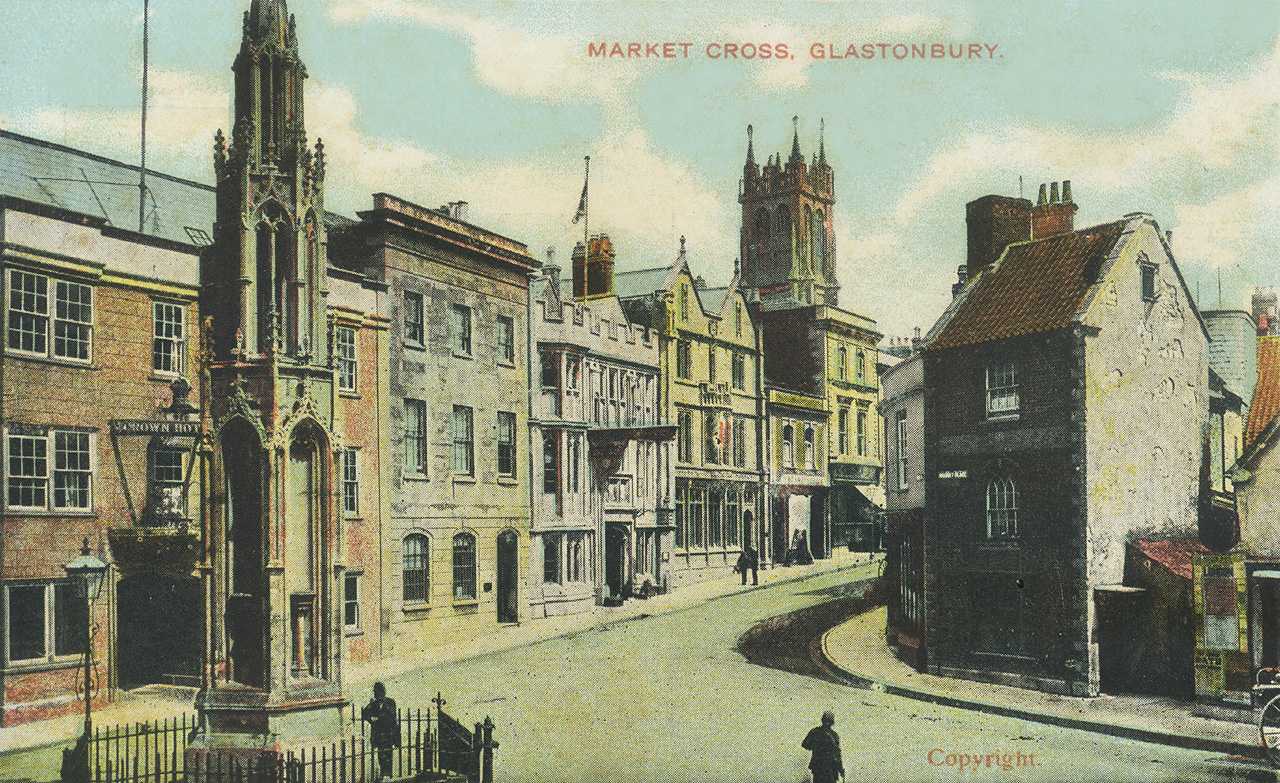 The Market Place in Glastonbury. Magdalene Street, in which the Crocker
family had its boot-making business, leads away to the right.
At some point we must assume that Reginald’s father came to Bath, perhaps for work. Ada Vanstone Reginald’s
mother’s family, the Vanstones, were a colourful family. Ada Vanstone’s
grandparents, James & Mary Ann Vanstone, lived in Somerset Street
in Bath (down the side of what is now the Bath City Church at the
Forum) and were occasionally featured in the
local newspaper in relation to petty cases before the Police Court. In
1852,
for example, it was (Mary) Ann who was being charged in relation to a
bout of
abusive shouting in the street. It
seems they ran a 'lodging house', as they sometimes had public quarrels
with
their own lodgers. In one case, in 1855, a lodger is charged with
having stolen
items from her room upon moving out. Interestingly, the report of that
event
mentioned that both James & Ann were at that time in prison. A
later report
(1857) of both James and Mary Ann being summoned for threatened assault
potentially explains this: Bath Chronicle & Weekly
Gazette, 17th September 1857 James Vanstone and Mary Ann Vanstone, who were sometime since
prosecuted and imprisoned for keeping a brothel, were summoned by Joseph
Mansfield for threatening to assault him. The complainant, who is a very old
man, stated that, on Friday night, between 9 and 10 o'clock, he was in Somerset
Street smoking his pipe. Mrs Vanstone was standing at her door, No. 7, and on
seeing him she went up to him and said, "You false swearing rascal, what
are you standing there for? I'll cook thy goose for thee some day. You wicked
old man, you'll never die a natural death. You have been watching my fine
ladies, and I cannot carry on my business for you." Her husband, James
Vanstone, then came up, and holding up a stick, said he would knock his brains
out." Witness further stated that he considered his life was in danger.
There was also a cross summons, in which Mr. Mansfield and his wife were
charged by Mrs. Vanstone with threatening to assault. Mrs. Vanstone stated that
on the same day during the above quarrel Mr. Mansfield threatened to do for
her, and serve her as he had done before. Mrs. Mansfield also called her very
disgraceful names, and said she should like to trample her under her feet. Mr.
Falkner, the magistrate’s clerk, asked where the police officers were all this
time? Mrs. Mansfield said the police never went near their premises, and Mrs.
Vanstone admitted that whenever she wanted the services of the police she could
never find one. The magistrates, Messrs. Kitson and Smith, after some
consultation, decided to bind over all the parties on both sides. Mr. Vanstone
and Mr. Mansfield in £10 each; and Mrs. Vanstone, and Mrs Mansfield in £5 each,
to keep the peace for three months. 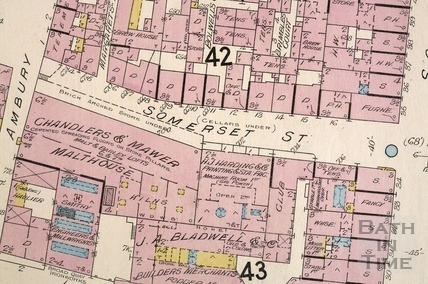 A 1902 map of Somerset Street, which used to run between the Ambury and Southgate Street and which was dominated by the large maltings at the western end. The properties marked ‘D’ on the northern side were dwellings. The area was altered significantly when St James Parade was continued southwards, slicing through the area in the upper part of this map, over which the Forum cinema was also built. The photograph below (essentially looking from the point of view of the blue dot on the map) shows Somerset Street prior to the building of the Forum cinema, but with the maltings still in existence. [Images: Bath In Time] 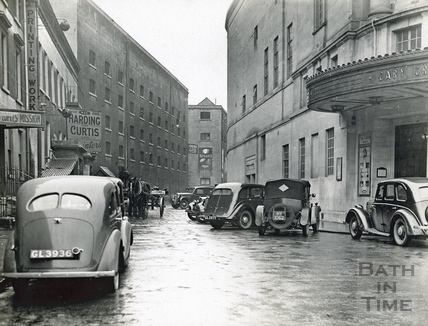 But James and Mary Ann Vanstone were not always on the same
side of the battle lines: Bath Chronicle & Weekly
Gazette, 28th February 1861 Using Threatening Language James Vanstone, apprehended under a
warrant, was charged with using threatening language towards his wife, Mary
Vanstone, and putting her in bodily fear, on the 20th inst. The prisoner, it
appeared, came home drunk, and told his wife to prepare for death, as he
intended to beat her brains out, at the same time flourishing a poker over her
head. Ordered to find bail to keep the peace for a month. Ada herself also grew up in Somerset Street. Her father (called
Ascott James Vanstone but known as James) was a saddler, like his father before
him and the family also took in lodgers. The 1871 census shows that the lodgers
were all men (perhaps through circumspection, following the family’s previous
misdemeanours), including one Carlo Casenaghi, a musician from Milan. But in 1877, Ada’s parents were seen to be continuing the
family’s relationship with the long arm of the law: Bath Chronicle and Weekly
Gazette - Thursday 18 January 1877 SATURDAY. Before Lieutenant-Colonel Ford (in the chair), Rear-Admiral
von Donop, Mr. Marshall, and Mr. Savage. Ascott James Vanston, and Sarah
Vanston, of Somerset-street, were summoned for assaulting Leah Potter, hawker,
of 6 Corn-street, on the 9th inst. The complainant said she owed the defendants
6s. for rent, and on the day named was visited whilst getting dressed, by Mrs.
Vanston who said, "How about the rent?" Witness replied that she
should have it but that she should come for it in a civil manner. Mrs. Vanston
then took up witness's dress, but, after a struggle, she was obliged to give it
up. She then threw the contents of a bucket and a basin over her and tried to
strike her with the bucket but complainant protected herself with a shovel.
Mrs. Vanston then sent for her husband, who took hold of witness roughly and
told her to go out of the house. The complainant's story was corroborated by
two fellow lodgers. Mr. J. K. Bartrum, who appeared for the defendants,
contended that the story was hatched up by the complainant and her witnesses,
who had received notice to quit their lodgings. There was a scramble about some
clothes in the bucket but there was no pretence for saying that Mrs. Vanston
threw water over the complainant. Mrs. Potter was summoned for assaulting Mrs
Vanston, who said that when she went to the house she received a good deal of
abuse from the defendant, and threatened to have the room emptied as a
consequence. Whilst she was removing a bolster, defendant struck her a blow on
the side of the head, and witness only took the bucket to defend herself from
the defendant, who had a shovel in her hand, and broke it in the affray. The
magistrates fined Vanston 7s. 6d. and costs, and his wife 5s. and costs, and
dismissed the other summons. Then, in 1882, the newspaper carried a sad story about how
Ada’s younger brother had drowned in the River. From the census entries in 1861
and 1871, a picture emerges of a family with Ada as the eldest daughter, then a
sister two years younger (Amy, born in London). The next child for whom there
is any record is Ernest James, who is the feature of the article below: Bath Chronicle and Weekly
Gazette - Thursday 25 May 1882 Sad Death of a Boy. At the Guildhall, on Saturday evening, Mr. A. H.
English, city coroner, held an inquiry concerning the death of Ernest James
Vanstone, four years of age, son of Mr. James Vanstone, harness maker, 6,
Somerset-street. According to the statement of John Thomas Garrett, a little
boy, he and the deceased were playing on the Old Quay, about three weeks ago.
They were amusing themselves by throwing stones at some ducks, when deceased
fell in and was drowned. This witness informed the coroner that four men were near
at the time, but did not attempt to rescue the unfortunate boy. Robert Comley,
Chapel-row, Weston, an employee at the Midland Saw Mills, gave evidence as to
finding the body in the river, near the saw mills, early that (Saturday)
morning. P.C. Richards said on the 6th instant he was on the Old Bridge when he
heard cries and saw something in the water a distance off. He and another
officer hurried to the spot, but before they arrived the deceased had sunk.
They dragged the river, but were not successful in recovering the body. The
father of the deceased having given evidence as to identification, the jury
returned a verdict of "Accidentally Drowned." The couple had another boy who they also called Ernest
James, before further children Alice & Herbert were born. Back to Reginald’s mother Ada: In the 1881 census, she was
listed as a ‘pupil teacher’, i.e. in training to become a teacher. | ||
The Crocker Family |
Ada married Alfred Crocker at Holy Trinity Church in St
James Street West in 1885. 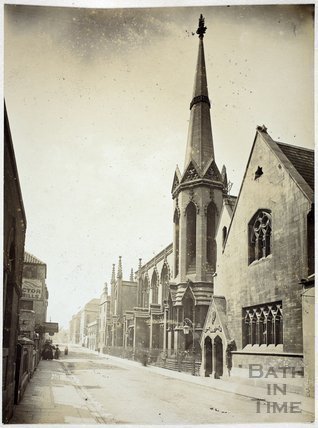 Holy Trinity Church and Hall in James Street West, where Reginald Crocker’s parents were married. This view is looking westwards and would now have the Odeon cinema on the left, and the modern block (with ‘Bathstore’ on the ground floor) replacing the church. The church was destroyed in bombing in 1942. Its dedication moved to the former St Paul’s (Monmouth Place). [Image: Bath In Time] 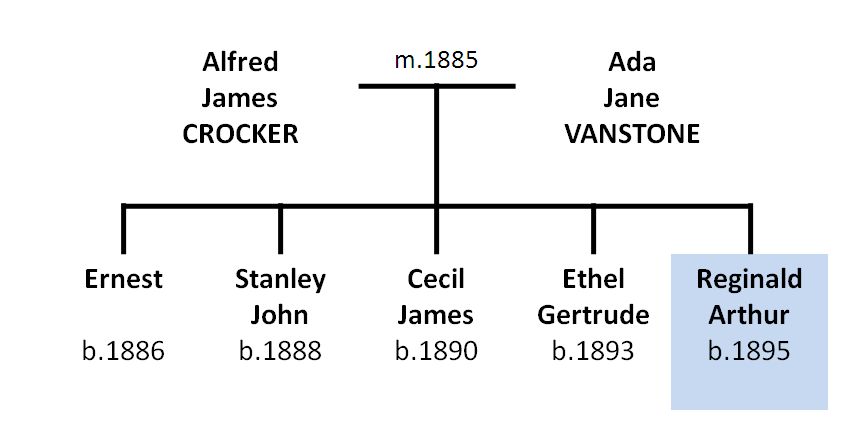 We don't know where Alfred & Ada lived between 1885-1891 as they do not appear in Bath Directories. the 1891 census shows them living at number 7 Nelson Villas, near Norfolk Crescent with the three eldest children already on the scene. They produced five children in all, of which Reginald Arthur was the youngest. Ada's widowed mother was living nearby at number 3 Nelson Villas in 1891. 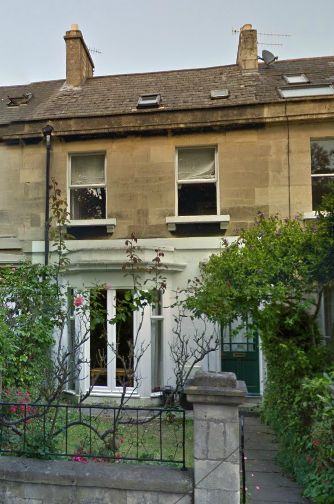 7 Nelson Villas |
|
Alfred Crocker was mentioned in the newspaper in connection with his cabinetmaking work in 1900: 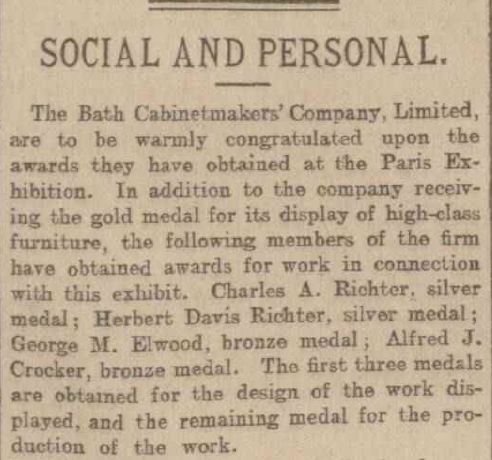 The 1901 census lists the family at 1 Cynthia Villas. This address today features just two houses where West Avenue meets Cynthia Road, but the 1891 census shows that seven addresses, (including addresses that are now numbered in West Avenue, such as the grocery shop on the corner), were then known as Cynthia Villas. Alfred was still a cabinet maker and Bath Directories listed him as a ‘Manager, Cabinet works’. Ernest was a junior clerk, already in employment at the age of 14; the other four children , at ages 5-12, would have probably still been in school. Reginald, the youngest, would have been starting out at South Twerton school later that year. Things changed, however, in 1908, when Reginald’s father
left cabinet-making behind him and became involved in his wider family’s business of
footwear. He opened a shoe shop in Hayes Place (the part of Bear Flat leading to the top of Holloway) and moved into a house
called ‘2, Carisbrooke Villas’, which is now 52 Lower Oldfield Park and
somewhat more grand than their previous abode in Cynthia Villas. The inscriptions 'Carisbrooke Villa' and '2' can still just be made out on the gatepost of number 52 Lower Oldfield Park. Alfred’s elder brother had been continuing the family shoemaking business in Glastonbury. At some point, the business was bought out by Clark’s of Street, who went on to become an international giant in the shoemaking industry. For some time, retail outlets for Clark’s were still called 'Crockers'. The 1911 census showed Reginald at age 15, working as a
junior clerk for the Bath municipal authority, with the rest of the family
engaged in the shoe shop business. |
Reginald Crocker in WW1 | ||
Army Service Corps, attached to 13th Battalion, the Welsh Regt.We need
to conduct more research on the details of Reginald Crocker's service with
the Welsh Regiment.In the absence of all other records, we know only from the inscription on the South Twerton memorial that Reginald Crocker had reached the rank of Corporal. His CWGC listing has him as 'Private' and this is more likely to be accurate. | ||
Reginald Crocker's Death | ||
| Reginald Crocker was killed in action on 8th October 1918, during the 2nd Battle of Cambrai. | ||
Burial | ||
The
Commonwealth War Graves Commission lists Reginald as buried where he fell on
the battlefield, and later re-interred in Prospect Hill Cemetery,
Gouy (between Cambrai and Saint Quintin) after the Armistice. The cemetery
was originally created after the capture of Prospect Hill on 3rd
October 1918 and the current Plot I reflects the extent of that cemetery. It
was extended when graves of soldiers such as Reginald Crocker were brought here
after November 11th. These were mainly from the battlefields north
of Gouy, and almost exclusively of men who died in October 1918. Reginald’s grave
is No 16, Row B, in Plot VI. 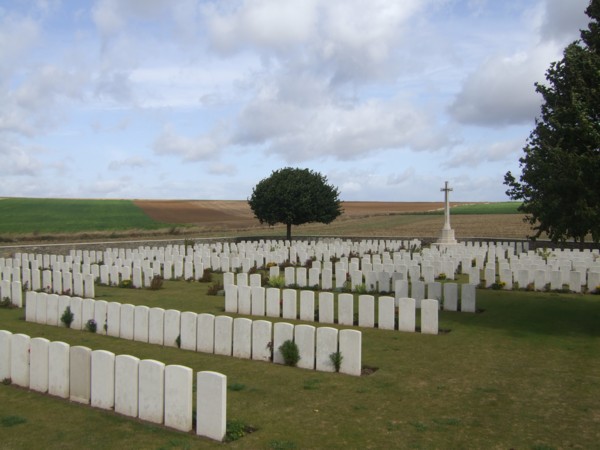 Prospect Hill Cemetery | ||
Prospect Hill cemetery was visited in June 2019 by Bath resident, Mike Sumsion, who has taken a keen interest in the Oldfield Park Junior School project and who visited the final resting place of a number of the school's 33 WW1 fallen servicemen on a trip to France and Belgium. In advance of his trip, we inscribed memorial crosses for him to take as a symbol of the school's ongoing remembrance of those who went from our community. Mike was kind enough to provide us with the following photographs from his trip: 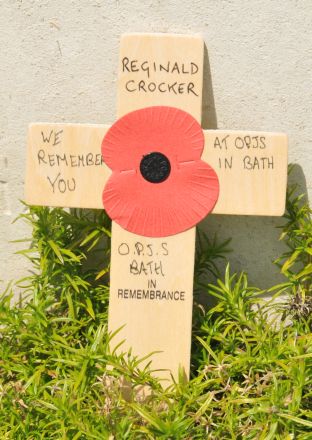 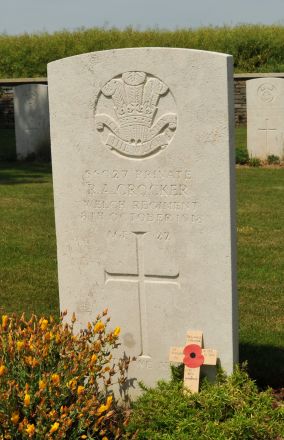 | ||
Decoration | ||
| Private Reginald Crocker would have been in receipt - posthumously - of the British War Medal and the Allied Victory Medal (possibly also the 1914 or 1914-15 Star). | ||
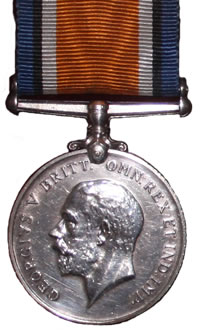 | 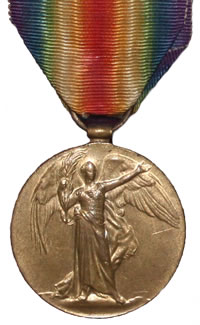 | ||
| British War Medal 1914-18 | Allied Victory Medal |
Commemoration | ||
 In addition to his commemoration on the South Twerton School memorial (on which he is denoted as 'Corporal'), Reginald Crocker is commemorated as follows: | ||
|
Lyncombe Parish (St Mark's) Memorial (now at Mary Magdalen Chapel, Holloway) Reginald Crocker is one of four of the South Twerton soldiers to be commemorated on a plaque that was installed in St Mark’s church in 1920. Although St. Mark's is some distance from the family home in Lower Oldfield Park, the parish of Lyncombe and Widcombe stretched as far as Brougham Hayes in those days. When St Mark’s was deconsecrated and decommissioned (it is now a community centre and pre-school), the memorial tablet was removed to St Mary Magdalen Chapel, Holloway, where it is displayed directly opposite the entrance. More details of this memorial are available on the Other Memorials page. |
|
Reginald Crocker’s name - alongside that of Clifford Daymond - on the Lyncombe St Mark’s memorial plaque,
which can now be seen in Magdalen Chapel on Holloway. | ||
|
Bath War Memorial See separate page for details of the Bath War Memorial. Reginald Crocker's inscription: |
 |
Further Information |
Living relativesIt would be great to hear from any living relatives of Reginald Crocker. There is significant information about Reginald and his family on ancestry.co.uk and we would love to have permission to replicate it here. We know that a relative supplied artefacts and information to an exhibition at the Bath Library in August 2014 and believe that he lives locally. Please do get in touch; we would love to talk to you and perhaps you could pass on more details to aid our project. Please get in touch!If you have any further information on Reginald Crocker, or want to suggest corrections / improvements for this page, please use the Contact page to get in touch. |